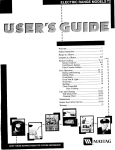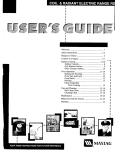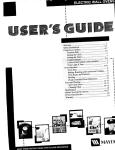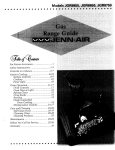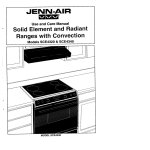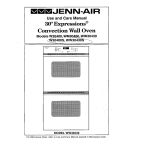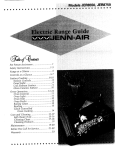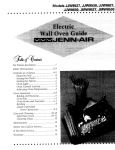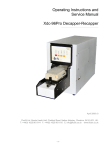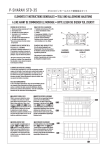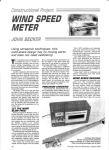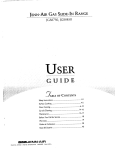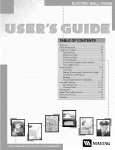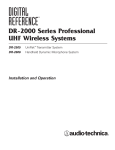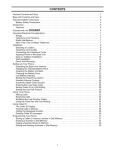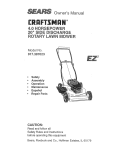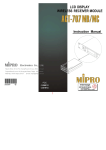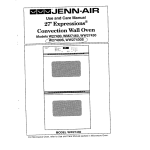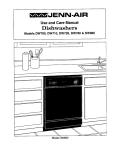Download Jenn-Air 81t2P180_60 User's Manual
Transcript
For Future Assistance Safety Instructions .............................. ............................... 1 2-3 Controls at a Glance ............................ 4-6 Function Pads .................................. 4-5 Setting the Clock ................................ 5 Setting the Timers ........................... 5-6 Oven Control Lockout ....................... 6 Adjusting Oven Temperature ............ .7 Oven Vent & Light ............................. 7 Oven Operation .................................. 8-16 Baking, Roasting and Convection Cooking ..................... 8 Oven Fans ........................................... 8 Convenience Foods ............................ 9 Oven Racks and Positions ................. 9 Baking Chart .................................... 10 Probe ................................................. 11 Broiling ............................................. 12 Clock Controlled .................................. Oven Operations ................... 13-14 Drying .......................................... 15-16 Care and Cleaning ........................... 17-20 Self-Clean Oven .......................... 17-18 Cleaning Chart ................................. 19 Maintenance .......................................... 20 Before You Call for Service .............. 21-22 If You Need Service ................................ 22 Warranty 23 ................................................ For Future Assistance Congratulations on your choice of a Jenn-Air electric wall oven. Your complete satisfaction is very important to us. Read this user's guide carefully. It is intended to help you operate and maintain your new wall oven. IMPORTANT: Keep this guide and the sales receipt in a safeplaceforfuture reference. Proof of originalpurchase date is needed for warranty service. If you have questions, write us (include your model number and phone number) or call: In addition, you will find a booklet entitled "Cooking Made Simple." It contains information on selecting bakeware and provides baking, roasting and broiling tips. Jenn-Air Customer Assistance Attn: CAIR ®Center P.O. Box 2370 Cleveland, TN 37320-2370 1-800-688-1100 1-800-688-2080 (U.S. TTY for deaf, hearing impaired or speech impaired) (Mon.- Fri., 8 am-8pm Eastern Time) Internet: http://www.maytag.com Save time andmoney. Check the "Before You Call" section of this guide. It lists causes of minor operating problems that you can correct yourself, However, should you need service, it is helpful to have the model and serial numbers available. This information can be found on the data plate located on the oven front frame. For service information, see backpage. These numbers are also on the Product Registration card that came with your appliance. Before sending in this card, record these numbers along with the purchase date below. Model Number __e_ Serial Number ¢P In our continuing effort to improve the quality and performance of our cooking products, it may be necessary to make changes to the appliance without revising this guide. Date of Purchase l_ For Microwave Oven operation fselect models j. refer to the use and care guide packed in mtcrowave oven. Important • • • • • • • • • • • • • • • • • • • • • • • • Safety Instructions • • • • • • • • • • • • • • • • • The following instructions are based on safety considerations and must be strictly followed to eliminate the potential risks of tire, electric shock, or persona/injury, • Children must be taught that the appliance and utensils in it can be hot. Let hot utensils cool in a safe place, out of reach of small children. Children should be taught that an appliance is not a toy. Children should not be allowed to play with controls or other parts of the unit. Installation • CAUTION: NEVER store items of interest to children in and Repair • Have your appliance installed and properly grounded by a qualified installer according to the installation instructions, • To ensure proper operation and avoid possible injury or damage to unit do not attempt to adjust repair, service, or replace any part of your appliance unless it is specially recommended in this book. All of the servicing should be referred to a qualified installer or servicer, cabinets above an appliance. Children climbing on the appliance or on the appliance door to reach items could be seriously injured. About Your Appliance • To prevent potential hazard to the user and damage to the appliance, do not use appliance as a space heater to heat or warm a room. Also, do not use t_e oven as a storage area for food or cooking utensils. To Prevent Fire or Smoke Damage • Do not obstruct the flow of air by blocking the oven vent. • Be sure all packing materials are removed from the appliance before operating it. • DO NOT TOUCH HEATING ELEMENTS OR INTER[OR SURFACES OF OVEN. Heating elements may be • Keep area around appliance clear and free from combustible materials. Flammable materials should not be stored hot even though they are dark in color. Interior surfaces of any oven become hot enough to cause bums. During and after use, do not touch, or let clothing or other flammable materials contact heating elements or interior surfaces of oven until they have had sufficient time to cool. Othe_ surfaces oft he appliance may become hot enough to caus_ bums - among these surfaces are: oven vent openings ant in an oven. • Many plastics are vulnerable to heat. Keep plastics away from parts of the appliance that may become warm or hot. • To prevent grease fires, do not let cooking grease or other flammable materials accumulate in or near the appliance, surfaces near these openings, oven doors, windows of ore doors. CAUTION: NEVER use an appliance as a step to reae cabinets above. Misuse of appliance doors, such as steF ping, leaning or sitting on the door, may result in possib tipping of the appliance, breakage of door, and seriot injuries. In Case of Fire • Use dry chemical or foam-type extinguisher or baking soda to smother fire or flame. Never use water on a grease fire. 1. Turn off appliance to avoid spreading the flame, • 2. NEVER pick up or move a flaming pan. 3. Smother fire or flame by closing the oven door. trical shock. • A fan should be heard during the bake, convect bake, c_ vect roast, broil and cleaning cycles. If you do not h, the fan, call an authorized servicer. Child Sa[ety • NEVER leave children alone or unsupervised near the appliance when it is in use or is still hot. Children should never be allowed to sit or stand on any part of the appliance as they could be injured or burned. Do not touch a hot oven light bulb with a damp cloth the bulb could break. Should the bulb break, disconne power to the appliance before removing bulb to avoid ele • NEVER use aluminum foil to cover an oven rack or o bottom. Misuse could result in risk of electric shock, f or damage to the appliance. Use foil only as dii,ectec this guide. Important Safety Instructions • • • • • • • • • • • • • • • • • • • • • • • • • • • • • • • • • • • • • • • Cooking Safety Cleaning Safety • Never heat an unopened food container in the oven. Pressure build-up may cause container to burst resulting in serious personal injury or damage to the appliance, • Turn off all controls and wait for appliance parts to cool before touching or cleaning. Clean with caution. Use care to avoid steam burns if a wet sponge or cloth is used to wipe spills on a hot surface. Some cleaners can produce noxious fumes if applied to a hot surface. * Use dry, sturdy potholders. Damp potholders may cause burns from steam. Dish towels or other substitutes should never be used as potholders because they can trail across hot elements and ignite or get caught on appliance parts. • Clean only parts listed in this guide. • Wear proper apparel. Loose fitting orlong hanging-sleeved apparel should not be worn while cooking. Clothing may ignite and cause burns if garment comes in contact with heating elements, Self-Clean Oven • Always place oven racks in the desired positions while oven is cool. Slide oven rack out to add or remove food, using dry, sturdy potholders. Always avoid reaching into the oven to add or remove food. If a rack must be moved while hot, use a dry potholder. Do not let potholder contact hot element in oven. age, or move the gasket. • Do not use oven cleaners or oven liners of any kind in or around any part of the self-clean oven. • Before self-cleaning the oven, remove broiler pan, oven racks and other utensils, and wipe off excessive spillovers to prevent excessive smoke or flare ups. • Use care when opening the oven door. Let hot air or steam escape before removing or replacing food. • CAUTION: Do not leave food or cooking utensils, etc. in the oven during the self-clean cycle. I_ PREPARED FOOD WARNING: Follow food manu" " ' frozen foo d container and/ facturer ' s instructions. If a plastic or its cover distorts, warps, or is otherwise damaged during cooking, immediately discard the food and its container, The food could be contaminated. • Do not allow aluminum foil or meat probe to contact heating element, • Always turn off all controls when cooking is completed. Utensil Safety • Do not clean door gasket. The door gasket is essential for a good seal. Care should be taken not to rub, dam- Important Safety Notice and Warning The California Safe Drinking Water and Toxic Enforcement Act of 1986 (Proposition 65) requires the Governor of California to publish a list of substances known to the State of California to cause cancer or reproductive harm, and requires businesses to warn customers of potential exposures to such substances. • Follow the manufacturer s &rectlons when using oven cooking bags. Users of this appliance are hereby warned that when the oven is engaged in the self-clean cycle, there may be some low-level exposure to some of the listed substances, including carbon monoxide. Exposure to these substances I_ This appliance has been tested for safe performance using conventional cookware. Do not use any devices or accessories that are not specifically recommended in this manual, Do not use add-on oven convection systems. The use of devices or accessories that are not expressly recommended in this guide can create serious safety hazards, result in performance problems, and reduce the life of the components of the appliance, can be minimized by properly venting the oven to the outdoors by opening the windows and/or door in the room where the appliance is located during the self-clean cycle. IMPORTANT NOTICE REGARDING PET BIRDS: Never keep pet birds in the kitchen or in rooms where the fumes from the kitchen could reach. Birds have a very sensitive respiratory system. Fumes released during an oven self-cleaning cycle may be harmful or fatal to birds. • Only certain types of glass, glass/ceramic, ceramic, earthenware, or other glazed utensils are suitable for oven setvice without breaking due to the sudden change in ternperature. Follow utensil manufacturer's instructions when using glass. Fumes released due to overheated cooking oil, fat, margarine and overheated non-stick cookware may be equally harmful. SAVE THESE INSTRUCTIONS Controls at a Glance The control panel is designed for ease in programming. The display window shows time of day, timer and oven functions. Indicator words flash to prompt your programming steps. In double ovens (select models), "U" indicates upper oven is ON and "L" indicates lower oven is ON. NOTE: Lower oven controls on double ovens only. Styling and features may differ slightly depending on the model. Aola_t Canc4)) I_ke Broil Clean ConvectRoas_ ConvectBake Drflng Oven Probe Ught / Cancel Bake Broil Clean / 5 0 //_\/__ 6 1 7 2 _ 3 9 4 _me Stop Clock Timar One _mer TWO \ _JENN-AIR _ \ // COOk )';me t Function Pads Broil • Touch the desired pad. Use for top browning and broiling. • Touch the Auto Set (0) pad or the appropriate number 1. Press Broil pad. pad(s) to enter time or temperature. • A beep will sound when any pad is touched, 2. Press the appropriate number pads to set broil temperature. The first number pressed will enter "Hi" broil. NOTE: Five seconds after entering the number, the time or temperature will automatically be entered, lfmore thanfive seconds elapse between touching a function pad and the number pads, thefunction will be cancelled and the display See page 12 for additional information. will return to the previous display. Use to set self-clean cycle. Clean 1. Press Clean pad. Number Pads Use to set time or temperature, 2. Press Auto Set (0) pad for "3:00" hours of cleaning, pre_, the appropriate number pads for the time desired aft_ "3:00" appears in the display. Press 2 for "2:00" hours or for "4:00" hours. Cancel See page 17-18 for additional information. Use to cancel all programming except Clock and Timer functions. Convect Bake Use for convection roasting. 1. Press Convect Roast pad. Use for conventional baking or roasting. 1. Press Bake pad. 2. Press the Auto Set (0) pad for 350° F or appropriate humber pads for desired temperature. See page 8 for additional information. Roast 2. Press the Auto Set (0) pad for 325° F or appropriate nu ber pads for desired temperature. See page 8 for additional information. Controls at a Glance • • • • • • • • • • • • • • • • • • • • • 3. Attheendofthetimeset, the timer will chime four times and "End" will appear in the display. If the timer is notcancelled (see "To cancel" below), "End" will remain in the display and there will be two chimes every 30 seconds for five minutes. • • • • • • • • • • • • • • • • • • • • Oven Control Lockout The oven operation controls - Bake, Broil and Self-Clean can be locked in the "OFF" position. The Timer and Clock controls can always be used regardless of the lockout. To cancel: 1. Press and hold Timer pad. After a slight delay the time of day will reappear. If an oven function is currently being used, the controls cannot be locked off. OR 2. PresstheTimerpadandthe"0"numberpad. delay the time of day will reappear. 1. Press and hold the Cook Time pad and the Stop Time pad at the same time for several seconds. (__e_ After a slight • ° ° To Set Controls • The indicator word "OFF" will appear and remain in the display for 15 seconds. someone presses an oven • are If locked off, the indicator function pad while controls word "OFF" will reappear • Pressing Cancel pad to cancel the .timer will cancel ALL selected oven functions except the timer. in the display for 15 seconds. To cancel: Press and hold the Cook Time pad and the Stop • If you would like to .eliminate, all the "reminder" Time pad at the same time for four seconds. The indicator chimes,_press and hold the Cancel pad for _2 seconds until a _ sounds. (This'will noieliminate the initiat four chimes.) To _restOre_there_ir_der chimes, press and hold the Cancel pad for 12 seconds. : word "OFF" will appear briefly and then disappear. [OVENRACKS] Rack #4):Mo Position b,o,iog. t #4o(offset rackon Single Oven - two fiat racksand one offsetrackwerepackaged with youroven. Rack Position#3: Mostbakedgoodsona cookiesheetor jellyroll pan. Toassureexcellentresultseverytimewhen roasting,usethe probesuppliedwith your walloven. Rack Position #30 (offsetrack on #3): Most bakedgoods,pies,layercakes. INSTALLING AND SETTING Double Oven - two fiat racks and one offsetrackplusanadditionaloffsetandfiat rackfor the lowerovenwere packaged in your oven. To remove: Pullforward to the "stop" position;lift uponthefront ofthe rackand pullout. To replace: Placerack on the rack support in the oven;tilt the front end up slightly;sliderack backuntil it clearsthe lock-stopposition;lower front and slide intothe oven. RackPosition #2: Roasting smallcutsof meat,cakesintube the center of the thickest part of the meatandnot intothe fat or touchinga bone. RackPosition #h Largecutsof meatandturkey,custard pie,dessertsouffle, 2. Insertthe probeplugintothe receptacle locatedon the top left of the oven. Be certainto insertplugintothe receptacle allthe way. • After the ,,._, Three racks (convectioncooking): Multiple Use#1,Rack #30, Cooking: #4. (Seeillustration.) .................................. NOTES: Threerackconvectioncooking. THE PROBE I. Insertthe probeintothefooditem. For meats,the probetip shouldbelocatedin or bundtpans,casseroles, Rack Position #20 (offseton#2): Roasting,loavesof bread,angelfood cake. Two racks: Use#20 and#4. RACKPOSITIONS PROBE I • Theuseoftheoffsetrackisdenotedin the listaboveasan"o" afterthe rack positionnumber, • Do not cover an entire rack with Flatrack) aluminumfoilorplacefoilontheoven bottom.Bakingresultswill beaffected ,ack) and damagemayoccur to the oven bottom, (flatrack) .... .......... ....... inserted, theindicator word probeis PROBE will flashanda beepwill soundremfndingyou to enterthedesiredprobe temperature. 3. PressProbe pad.Thedisplaywill show three dashes. 4. Pressthe appropriatenumberpadsto set the internal temperaturedesired. (Allowablerangeis 100° to 200°F.) • Afterfivesecondsthedisplaywi]lshow probetemperatureor 95°, whichever is higher,indicatorwordsCONV, BAKE,ROASTwill flash. 5. PressBake or Convect Roast pad. Thedisplaywill showthree dashes. 6. Pressthe appropriatenumberpadsfor desiredoventemperature. 7. When the selectedinternal temperature of the food hasbeenreached,the ovenwill shutoffandachimewill sound four times. Theactualprobetemperature will alsoflashandthe word "End" will beshownin the display. Oven • • • • Operation • • • • • • • • • • • • • • • • • • • • • • • • • • • • • • • • • • Adjusting Oven Temperature Oven Light If you think the oven should be hotter or cooler, you can adjust it yourself. To decide how much to change the thermostat, set the oven temperature 25°F higher or lower than the temperature in your recipe, then hake. The results of the "test" should give you an idea of how much to adjust the thermostat. The oven light automatically comes on whenever the oven door is opened. When the door is closed, press the Oven Light pad to turn the oven light on or off. A beep will sound every time the Oven Light pad is touched. To adjust the thermostat: Oven Vent 1.Press the Bake pad. 2.Enter 500° by pressing the number pads "5, 0, 0". When the oven is in use, the area near the oven vent may feel warm to the touch. Do not block the vent opening for best baking results. 3. Press and hold the Bake pad for several seconds until 00° appears in the display. If the oven temperature was previously adjusted, the change will be displayed. For example, if the oven temperature was reduced by 15°, the display will show 15°. 4.Press the appropriate number pads to select the temperature change desired. The oven temperature can be increased up to 35° (+35°) or reduced by as much as 35° (-35 °) in 5° increments. Pressing the Broil pad will change the - sign to a positive number or back to a negative number. 5.The oven will now bake at the adjusted temperature. It is not necessary to readjust the oven temperature if there is a power interruption. This adjustment will not affect broil or clean temperatures. NOTE: Do not change the temperature setting more than 10° at a time before testing the oven. The oven vent is located below the control panel on your wall oven. • Oven Operation • • • • • • • • • • • • • • • • • • • • • Baking, Roasting and Convection Cooking Every oven has its own characteristics. Youmay find that the cooking times and temperatures vary slightly from your old oven. This is normal, • • • • • • • • • • • • • • • • • • • • When the oven is preheated, the oven will chime and the ON7-11 and PREHEAT will go off. Allow minutes for indicator the oven words to preheat. 4. At the end of cooking, turn the oven off by pressing the Cancel pad. Remove food from oven. The oven will continue operating until the Cancel pad is pressed. Oven Fans A cooling fan will automatically turn on during cleaning, broiling and some baking operations. It is used to help keep internal parts on the control panel cool. The fan will automatically turn off when parts have cooled. The fan may continue to operate after the oven has been turned off. This is normal. A convection fan is used to circulate hot air in the oven when the convection feature is selected. It automatically turns on whenever the CONVECT pads are pressed and will turn off when CONVECT is canceled. • Whenever the ON indicator word appears in the display, the oven is heating: NOTE: The convection fan will automatically stop whenever the oven door is opened, Bake, temperature willbe displayed briefly and then return to the on, going program. Setting the Controls for Baking, Roasting, Convection Baking and Convection Roasting 1. Place oven racks on proper rack positions. (See page 9.) 2. Press Bake, Convect Bake or Convect Roast pad. oven temperature. If you are lowering the tempem_ ture below the current oven temperature, the indiCatot words PREHEAT and ON will appear briefly and ROAST will flash and three dashes will appear, 3. Press the Auto Set (0) pad to set 350° F automatically, When convection cooking, 325° F will automatically set when Auto Set (0) pad is pressed. Or, press the appropriate the preheat chime will sound. • As a general rule when convection baking, set the oven temperature 25 ° F lower than the conventionalrecipe or prepared mix directions. Times will be similar to a few minutes less than directions. (See chart on page 10 to compare times andtemperatures of many baked foods.) number pads for the desired oven temperature. • The temperature can be set from 100° to 550° F. in 5° increments, • When using the Convect Roast pad, roasting times are generally 25-30% less. (Maintain conventional roasting temperature.) • After five seconds the oven will begin to preheat. The indicator words ON and PREHEAT will appear in the display and 100° or the actual oven temperature, whichever is higher. • For additional baking, roasting and convection cook= ing tips #us a roasting Chart with recommended roasting temperatures and times, see "Cooking Made Simple" booklet. • The indicator word BAKE, CONV BAKE or CONV • The temperature in the display will increase in 5° increments until the oven reaches the preset temperature. ¢ Oven Operation • • • • • • • • • • • • • • • • • • • Convection Cooking of Convenience Foods • • • • • • • • • • • • • • • • • • 4 Rack Positions • For best results, use the Convect Roast pad. • Preheating the oven is not necessary. flat rack) • Follow package recommendations for oven temperature, foil covering and the use of cookie sheets. Cooking times will be similar. (See chart below for some exceptions.) • Most foods are cooked on rack position #3o (offset on #3). • For multiple rack cooking with convection, use racks #1 and 30 and 4. However, pizzas should be placed on cookie sheets and cooked on rack positions #2o, 3 and 4. -- 1 (flatrack) Three rack convection cooking. Rack Position #4o (offset rack on #4): Cooking Chart for Convenience Food s ConvectRoast OvenNotPreheated Frozen Rack Convenience Foods Position* Temp.oF Minutes** Chicken, fried FishSticks FrenchFries Pot Pies Pizza 30 3 3 30 30 375° 400° 450° 400° 400° 40-45 13-18 15-25 30-35 13-18 *An"o" afteraracknumberimpliesthattheoffsetrackshouldbeused. **The timesgivenarebased on specificbrandsof mixesor recipes tested.Actualtimeswilldependonthe onesyoucook. Oven Racks Most broiling. Rack Position #3: Most baked goods on a cookie sheet or jelly roll pan. Rack Position #3o (offset rack on #3): Most baked goods, pies, layer cakes. Rack Position #2: Roasting small cuts of meat, cakes illtube or bundt pans, casseroles. Rack Position #20 (offset on #2): Roasting, loaves of bread, angel food cake. Rack Position #1: Large cuts of meat and turkey, custard pie, dessert souffle. Single Oven - two flat racks and one offset rack were packaged with your oven. Multiple Rack Cooking: Two racks: Use #2o and #4. Double Oven - two flat racks and one offset rack plus an additional offset and flat rack for the lower oven were packaged in your oven. Three racks (convection cooking): Use #1, #3o, #4. (See illustration above.) To remove:Pull forward to the "stop" position; lift up on the front of the rack and pull out. To replace: Place rack on the rack support in the oven; tilt the front end up slightly; slide rack back until it clears the lock-stop position; lower front and slide into the oven. _(_"_/l_J • The use of the offset rack is denoted in the list above and in the charts as an "o" after the rack position number. • Do not cover an entire rack with aluminum foil or place foil on the oven bottom. Baking results will be affected and damage may occur to the oven bottom. Oven Operation • • • • • • • • • • • • • • • • • • • • • • • • • • • • • • • • • • • 9" 9" tube 9x5 loaf 2 pans 30 or 3 30 or 3 20 or 2 2 20 & 4 325° 325° 350° 300° 325° 20-30 25-30 30-35 50-60 15-20 350° 350° 375° 325° 350° 25-30 30-35 30-40 55-65 15-25 9" 3o 350°-400° 45-60 375°-425° 45-60 9" I 325°-375° 40-50 3500-400° 40-60 3 3 30 or 3 30 or 3 325°-350° 325°-375° 6-10 6-10 350°-375° 350-400° 7-11 7-11 350° 25-31 Brownies ' 9x13" 30 325° 20-26 Breads - Yeast Loaf ' Rolls , : 9x5" 1 or 20 3o 350° 350o-375° 17-23 9-14 I _'_75° 375°-400° 18-28 12-15 ' ' 8x4" 8x8" 20 30 3 or 3o 3o 325%350° 3750-420° 375°-400° 350°-400° 40-55 13-28 7-11 15-20 350o-375° 400°-45& 400°-425 ° 3750-425° 50-65 15-30 8-15 15-25 30 3o 400° 325° 45-50 45-55 425° 350° 55-65 55-65 Breads- Quick Loaf Cornbread Biscuits Muffins Vegetables Potatoes (reed.) Do notwrapin foil, prick with fork, : _ Casserole I * An "o" after a rack number implies that the offset rack should be used. ** The times given are based on specific brands of mixes or recipes tested. Actual times will depend on the ones you bake. *** The Convect Bake temperature is 25° F lower than recommended on package mix or recipe. • • • • • • ]]Oven • • • • • Operation • • • • • • • • • • • • • • • 41. • • • • • • • • • • • • • • • • • Probe To assure excellent results every time when roasting, use the probe supplied with your wall oven. " ° • _The probe must be removed from the oven when it is Installing and Setting the Probe 1. Insert the probe into the food item. (For meats, the probe tipshould be located in the center of the thickest part of the meat and not into the fat or touching a bone.) 2. Insert the probe plug into the receptacle located on the top left of the oven. Be certain to insert plug into the receptacle all the way. serted, the indicator word PROBE will flash and a beep will sound reminding you to enter the desired probe temp• After the probe is inerature. 3. Press Probe pad. The display will show three dashes. 4. Press the appropriate number pads to set the internal temperature desired. (Allowable range is 100° to 200°F.) • After five seconds the display will show probe temperature or 95°, whichever is higher. Indicator words CONV, BAKE, ROAST will flash. 5. Press Bake or Convect Roast pad. The display will show three dashes. 6. Press the appropriate number pads for desired oven temperature. 7. When the selected internal temperature of the food has been reached, the oven will shut offand a chime will sound four times. Plus, the actual probe temperature will flash and the word "End" will be shown in the display. A chime will sound every minute for 10 minutes or until the Cancel pad is pressed. • If the probe is not removed, a beep will sound continuously until the probe is removed. (Hold probe plug with a potholder when removing from the oven.) be usea. • Because of the excellent insulation of the oven, the retained heat Continues to :cook the 'food after the signal has sounded and the oven has cycled off. For this reason it is important to [emove the food from the Oven as soon as the signal sounds, • Use the handle of the probe for inserting or removing. Do not pull on the cable. Use a pot,holder to remove • For frozen meats, insert probe after 1-2 hours of roasting. • To clean cooled probe, wipe with a soapy dishcloth. since becomes Do notprobe submerge probehot. in water. • Oven Operation Broiling For best results, use a pan designed for broiling. For addi- tional broiling tips, see "Cooking Made Simple" booklet. Chart time based on a ,reheated broil _ lement using He "Hi" setting Rack Setting the Controls for Broiling 1. Place the oven rack on the proper rack positon. (See following chart.) 2. Press the Broil pad. Beef Steak (1"):! Medium Well ,, Hamburgers (3/4): Medium Well 40 4o 9 11 7 8 4o 4o 5 6 3-4 4-5 Pork Chops (1/2") Chops (1") Ham Slice 40 3 40 7 10-11 4 5-6 9-10 2-3 a lower broil temperature can be selected. To select a lower temperature, press the appropriate number pads for the temperature desired after "Hi" appears in the display. Poultry Breast Halves (Bone-in) 3 11-12 9-11 • Five seconds after entering "Hi" or a temperature, the broil element will come on and the indicator words BROIL and ON will remain in the display. (If a Seafood Fish Steaks, Buttered (1") 4o 8-10 (no turning) • Indicator word BROIL will flash and three dashes will appear. 3. Presstheappropriatenumberpad(s). Thefirstnumberpad pressed will enter "Hi" broil. • The oven has a variable broil feature which means that lower temperature is selected, the ON indicator word will cycle on and off with the element.) *An "o" after the rack number irn _liesthat the offset rack should be used. 4. Preheat five minutes until broil element is red. Cook food according to the following broiling chart. Oven door MUST be left open at the broil stop position during cooking. Note: This chart is a suggested guide. Thc times may vary with food being cooked. 5. Press the Cancel to turn off oven when food is cooked. (/e4 •. • • If more that five seconds elapse between pressing the Broil pad and number pad, the oven is not set and the display will return to the previous display, • A cooling fan will automatically turn on during broiling. If it does not operate, contact an authorized servicer. • "Hi" is used for most broiling. Use a lower broil temperature when broiling longer cooking foods or thin pieces of food; The lower temperature allows food to cook to the well done stage without excessive browning. • Expect broil times to increase and browning to be slightly lighter if appliance is installed on a 208 volt circuit. ] Oven • • • • • Operation • • • • • • • • • • • • • • Clock Controlled Oven Operations The clock controlled oven cooking feature is used to turn the ovenoffat apreset time of day or delay the start andthenturn off the oven. The clock must be functioning and set at the correct time of day for this feature to operate correctly, The feature can be used with either oven cooking or self cleaning. See page 18for instructions on delaying the startof • • • • • • • • • • • • • • • • • • • • After five seconds, the time of day returns to the display. , The temperature in the display will increase in 5° increments until the oven reaches the preset temperature. • When the oven is preheated, the oven will chime and the ON and PREHEAT indicator words will go off. 5. At the end of the programmed Cook Time, the oven will shut off automatically and a "chime" will be heard four times and "End" will appear in the display. Press the Cancel pad. a clean cycle. If oven is not cancelled, "End" will remain in the display and there will be one chime every minute for 10 Setting the Controls minutes. To StartImmediately andTurn Off Automatically: 1. Press the Bake pad. • The indicator word BAKE will flash and three dashes will appear in the display. 2. Press the Auto Set (0) pad or the appropriate number pads for the desired oven temperature, • The temperature can be set from 100° to 550° in 5° increments. It e I • One minute bef0re the end Of Cook time. the oven completed. Thelight canbe turned off prior to theend of theWill Chimes the Oven Light light come 1on until the end-of-cycle chimes are • After five seconds the oven will begin to preheat. The indicator words ON and PREHEAT will appear in the display and 100°or the actual oven temperature, whichever is higher. 3. Press the Cook Time pad. The indicator words COOK TIME will flash and the display will show "0HR:00". 4. Press the appropriate number pads to enter cooking hours and minutes. (Allowable range is 5 minutes to 11 hours and 55 minutes.) Example: If cooking time selected for convection baking is 2 hours and 30 minutes, the display will show: To Delay the Start and Turn Off Automatically: 1-4. Follow preceding steps 1_4. 5. Press the Stop Time pad. Indicator words STOP and TIME will flash. (Display will show the calculated stop time based on the current time of day and the cook time that you entered previously.) Oven Operation 6. Press the appropriate number pads to enter the time you wish the oven to stop. A stop time can only be accepted for later in the day. Example: If at 10:00 you set the oven for 350° convection baking and 2 hours and 30 minutes of cooking time, the calculated stop time would be "12:30". The display would show: m_ If you want the stop time to be 1:00, press the number pads "1,0,0. Five seconds later, the display will briefly show the start time of 10:30 along with the indicator words DELAY, START TIME. I 0 ;3 0 _ _ 3 _0° After five seconds, the display will return to the current time of day along with the indicator words DELAY, TIMED. I0:00 _ _ o° At the end of the delayed period, the DELAY indicator word will go off and the oven will begin to heat. 7. At the end of the programmed Cook Time, the oven will shut off automatically and a "chime" will be heard four times and "End" will appear in the display. Press the Cancel pad. If the oven is not cancelled, "End" will remain in the display and there will be one chime every minute for 10 minutes. ° ° ° • tf more than five seconds elapse between pressing a function pad and pressing the appropriate number pads. the oven is NOT set and display wilt return to • In double walt ovens, the clock controlled feature can be used with only one oven at a time. • In double wall ovens, if one oven is set for clock controlled baking, the other oven cannot be set to self-clean. • To recall the time programmed, press the appropriate time pad. • To cancel a timed function, hold the Cook Time pad for four seconds. This will only cancel the cook time and stop time. not the set bake temperature, • Clock controlled COokingis not recommended for baked items that require a preheated oven, such as cakes, cookies, pies and breads. For these foods, place food in preheated oven and set the timer to signal the end of baking ume. • Highly perishable foods such as dairy foods, pork, poultry, or seafood are not recommended for clock controlled cooking with a delayed start. ] Oven Operation Drying For best results, use a drying rack. It allows air to circulate evenly around the food. The convection fan will operate during the drying procedure, Setting the Controls for Drying • The indicator word DRYING will flash and three dashes will appear, 2. Press the Auto Set pad for 140° F or press the appropriate number pads for the desired drying temperature. • The temperature may be set between 100° - 200° F. 3. The oven door needs to be opened slightly to allow moisture to escape from the oven during the drying process. • Open the oven door slightly, • Place the magnetic door spacer (Part No. 8010P131-60) on the slightly recessed circular area on the upper center of the oven door. The spacer provides a gap between the oven frame and the oven / spacer NOTE: If the spacer not placed is correctly, the convection fan will not operate. a drying rack, Co,_act_yolar Jenn-Air _'DRYINGRACK Accessory Kit or lu800+688-8408. • Most fruits:and vegetabl_ dry well .and retain their color when dried at 140° F. Meat and]erky should be 1. Press the Drying pad. door allowing moisture to escape. ° ° ° • The length of drying times vary due tOthe following: Water and sugar content of food. size of food pieces, amount of food being dried, humidity in the air. • Check foods at the minimum drying time. Dry longer if necessary. • Fruits that turn brown when exposed to air should be treated with an antioxidant. Try one of the following methods:: i, :Dip fruit in a mixture of two parts bottled lemon juice to one part co01 water. 2. Soak fruit in a solution of 1 tsp. ascorbic acid or commercial antioxidant to 1quart of cold water. • Foods may drip during the drying process. After drying high acid or sugary foods, clean the oven bottom with soap and water. The porcelain oven finish may discolor if acid or sugary food soils are not wiped up prior to high heat or a self-cleaning cycle. _' • More than one rack of food may be dried at the same time. However. additional drying time is needed. • Gently close the oven door until the spacer rests against the oven frame and light plunger The oven light will remain OFF when the spacer is in the correct location. Follow the drying guide on page 16 for drying times. Cool foods to room temperature testing for aloneness. dried at 145_ -i 50° F. For optimal flav0_, dry herbs at t00 ° F. however, at this lower temperature expect extended drying times of up to 8 hours. • Refer to other resources at your local library or call your local County Extension service for additional information. before 4. When drying is complete, turn the oven off by pressing the Cancel pad. Using a potholder, remove the magnetic spacer. NOTE: Please keep the magnetic spacer in a safe and convenient place for easy access. To replace, call 1.800688-8408 to order Part No. 8010P131-60. Oven Operation • • • • • • • • • • • • • ¢. • • • • • • • • • • • • • • • • • • • • • • • /6 • • • Guide Fruits .... Varieties Best for Drying Preparation Approx. Drying Time at 140°F ** Test for Doneness Apples* FirmVarieties:Graven Stein,GrannySmith, Jonathan,Winesap, RomeBeauty,Newton Wash,peelif desired,coreandslice into 1/8"slices, 4-8hours Pliableto crisp.Dried applesstorebestwhenthey areslightlycrisp. Apricots* Blenheim/Royalmost common.Tritonalsogood Wash,halve,andremovepits, 18-24hours Soft,pliable. Bananas* FirmVarieties Peeland cutinto 1/4"slices. 17-24hours. Pliableto crisp. Cherries Lambert,RoyalAnn, Napoleon,Vanor Bing Washandremovestems.Halveand removepits. 18-24hours. Pliableandleathery. Nectarines andPeaches* FreestoneVarieties Halveandremovepits. Peelingis optionalbut resultsin better-looking driedfruit. 24-36hours Pliableandleathery. Pears* Bartlett Peel,halveandcore. 24-36hours Softandpliable. Pineapple Freshor canned. Wash.peel andremovethornyeyes. Canned: Slicelengthwiseandremovethesmall 14-18hours core.Cutcrosswiseinto 1/2"slices, Fresh: 12-16hours Soft andpliable. Orangeand LemonPeel Selectrough-skinnedfruit. Do notdry thepeelof fruit marked"coloradded" Washwell.Thinlypeelthe outer 1/16 to 1/8"of thepeel.Donot usethe whitebitterpithunderthepeel. 1-2hours Toughto brittle. Tomatoes Plum,Roma Halve,removeseeds.Placetomatoes skinsideuponrack.Prickskins. 12-18hours Toughtocrisp. Carrots DanversHalfLong, Imperator,RedCored Chantenay Do notusecarrotswithwoodyfiber or 4-8hours pithycore.Wash,trimtops andpeelif desired.Slicecrosswiseor diagonally in 1/4"slices.Steamblanchfor 3rain. Toughto brittle. HotPeppers Ancho,Anaheim Wash,halveandseed.Prick skin severaltimes, 4-6hours Podsshouldappearshriveled dark redandcrisp. Parsley,Mint, Cllantro,Sage, Oregano Rinseincoldwater.Leavestemson untilleavesaredry,thendiscard. 1-3hours Brittleandcrumbly. Basil Cutleaves3 to4"fromtopofplant just asbudsappear.Rinseleavesin coldwater. 2-5hours Brittleandcrumbly, Vegetables Herbs *Fruits reqmring an antioxidant to prevent discoloration and loss of nutrients. Refer to the notes on page 10 f specific methods. ** 12 Hour Off will not occur during drying functions. • Care and Cleaning • • • • • • • • • • • • • • • • • • • Self-Clean Oven • • • • • • • • • • • • • • • • • • • • Setting the Controls fora Self-Clean Cycle 1. Close the oven door. The self-clean cycle uses above normal cooking temperatures to automatically clean the entire oven interior. While this occurs, a device in the oven vent helps consume normal amounts of smoke. The oven is vented through an opening under the control panel, NOTE: Both ovens cannot be self-cleaned at the same time in double wall oven models. It is normal for flare-ups, smoking or flaming to occur during cleaning if the oven is heavily soiled. It is better to clean the oven regularly rather than to wait until there is a heavy build-up of soil in the oven. During the cleaning process, the kitchen should be well ventilated to help eliminate normal odors associated with 2. Press the Clean pad. • The indicator words CLEAN TIME will flash and the display will show " HR: ". (Double wall oven models will also have a"U" or "L" indicating upper or lower oven.) 3. Press Auto Set (0) pad and "3:00" hours will appear in the display for an average soiled oven. • The cleaning time can be varied depending on the amount of soil. After "3:00" appears in the display, press the number 2 pad and enter "2:00" hours of cleaning for light soil. The number 4 pad will enter "4:00" hours for heavy soil. cleaning, Do not use commercial oven cleaners on the self-clean oven • Five seconds after entering the cleaning time, the oven door will automatically latch and the cooling fan will come on. finish or around any part of the oven as they will damage the finish or parts, • The indicator words LOCK and ON will come on when the door is latched. Before Self-Cleaning • The indicator word ON will cycle with the elements as the cleaning temperature is maintained. Remove broiler pan, all pans and the oven racks from the oven. The oven racks will discolor and may not slide easily after a self-clean cycle, 4. When the cleaning time has been completed, the indicator words CLEAN and ON will go off. The indicator word LOCK and the cooling fan will remain on until the oven has cooled andthe door has unlocked. Clean oven frame, door frame (area outside the doorgasket) and around the opening in the door gasket with a nonabrasive cleaning agent such as Bon Ami* or detergent and water. These areas are not exposed to cleaning temperatures andshould becleaned to prevent soil from baking on during the clean cycle, About one hour after the end of the clean cycle, the lock will disengage and the LOCK indicator word will turn off. To prevent damage, do not clean or rub the gasket around the oven door. The gasket is designed to seaI in heat during the clean cycle. At this point, the door can be unlocked and opened. Some soil may leave a light gray, powdery ash which can be removed with a damp cloth. If soil remains, it indicates that the clean cycle was not long enough. The soil will be removed during the next clean cycle. If the oven racks were left in the oven and do not slide Wipe up excess grease or spillovers from the oven bottom to prevent excessive smoking, flare-ups or flaming smoothly after a clean cycle, wipe racks and embossed rack supports with a small amount of vegetable oil to restore ease of movement. during the clean cycle. For ease of cleaning, the heating element can be lifted slightly (1 to 1-1/2 inches), Wipe up sugary spillovers and acid spillovers such as lemon juice, tomato sauce or milk-based sauces. Porcelain enamel is acid resistant, not acid proof. The porcelain finish may discolor if acid spills are not wiped up prior to a self-clean cycle. A white discoloration may appear after cleaning if acid or sugary foods were not wiped up before the clean cycle. This is normal and will NOT affect performance. After Self-Cleaning Care and Cleaning • • • • • • • • • • • • • • • • • • • • • • • • • • • • • • • • • • • • • • 4. • • To Delay the Start of a Clean Cycle To Cancel Self-Clean 1-3. Follow steps 1-3 on page 14. 1. Press the Cancel pad. The door will be locked while the LOCK indicator word remains in the display. 4. Press the Stop Time pad. Indicator words STOP TIME will flash in the display and CLEAN and the calculated stop time will also appear in the display, 5. Press the appropriate number pads to enter the stop time. A stop time can only be accepted for later in the day. Depending on the length of time the oven had been cleaning, it may take up to an hour for the oven to cool down. When the oven is cool the door will unlock and the cooling fan will turn off. hours, the stop time would be "12:00". The display willcalculated Example: Ifshow: at 9:00 you set the oven to clean for three !; : 12:00 If you want the stop time to be 1:00, press the number pads "1,0,0". Five seconds later the display will briefly show the start time and the indicator word DELAY. Afler a brief time, the display will return to the current time of day with the indicator words DELAY TIMED CLEAN remaining in the display. not • If more than five seconds elapse be_eenpressing 9'0 DgXAy 0 111rdE_ C1_,/¢4 gram will automatically return t0 the prex_i0usdis_ the Clean pad and pressing a number pad, the proplay. When the oven begins to clean, the indicator word ON and the cooling fan will come on. The indicator word DELAY will go off. • The oven door will be damaged :if the oven door is forced to open when the LOCK indicator word is still displayed. When the clean time has been completed, the indicator words CLEAN and ON will go off. The indicator word LOCK and the cooling fan will remain on until the oven has cooled down and the door has been unlocked, • The first :few times the oven is cleaned, some smoke and odor may be detected. This is normal and w_ll lessen or disappear with use. If the oven is heavily soiled, or if the broiler pan was accidently left in the oven, excessive smoke and odor may Occur. • :Asth e Ovenheats and cools, you,may hear sounds Of metal parts +xpanding and Contracting. Thi:s is norreal and will n_t damage your appliance, : i ]9 Care and Cleaning Be sure all controls are OFF and all parts are cool before cleaning. • To prevent staining or discoloration, clean appliance • If a part is removed, be sured it is correctly replaced. after each use. Cleaning Chart Parts and Insert Cleaning Procedure Never cover insert with aluminum foil as this prevents thefat from draining to the pan below. •Place soapy cloth over insert andpan; let soak to loosen soil. • Wash in warm, soapy water.Use soap-filled souring pad to remove stubbornsoil. • Broiler pan andinsertcan be cleaned in dishwasher. ....................................... ii...... • Wipe with a damp cloth. Dry thoroughly. • Glass cleanersmay be usedif sprayedon a cloth first.Do NotSpray Directly On The Pan l • Do not use other cleaning sprays, abrasive cleaners or large amounts of water on the panel. • Wash with soap and water or mild liquid sprays and a soft cloth. Donot use abrasivecleanersor oven cleaners on plastic finishes. • To prevent staining or discoloration, wipe up fat, grease or acid (tomato, lemon, vinegar, milk, fruit juice, marinade) immediately with a dry paper towel or cloth. • Wash with soap and water or glass cleaner. Avoid using excessive amounts of water which may seep behind or under the glass. • Do not use abrasive cleaners. • Wash with soap and water, glass cleaners or mild liquid sprays. Avoid using excessive amounts of water. • Remove stubborn soils with nonabrasive cleaners such as Bon Ami* or a baking soda and water paste; rinse and dry. Do not use abrasive cleaners. • See pages 17and 18 for information on the self-clean oven. • To remove occasional spillovers between cleanings, use a plastic soap-filled scouring pad; rinse well. : •Wipe sugary spillovers acid spillovers lemon tomato sauce or milk-based sauces.upPorcelain enamel isand acid resistant, not such acid as proof. Thejuice, porcelain finish may discolor if acid spills are not wiped up prior to a self-clean cycle. • Rub with a sponge or cloth using one of the following cleaners: Bon-Ami*, Soft Scrub* or Comet*. Rinse and dry. • For hard to remove soils, use a dampened soap-filled scouring pad. Rinse and dry. • Racks will permanently discolor and may not slide smoothly if left in the oven during a self-clean operation. If this occurs, wipe the rack and embossed rack supports with a small amount of vegetable oil to restore ease of movement, then wipe off excess oil. • Brand names for cleaning products are registered trademarks of the respective manufacturers. Maintenance About Cleaning Products Oven Light Becauseofthemanynewcleaningproductsintroducedinthe marketplace each year, it is not possible to list all products that can be safely used to clean this appliance. Listed below Before replacing light bulb, DISCONNECT POWER TO OVEN. Be sure bulb is cool. Do not touch a hot bulb with a damp cloth as the bulb may break. are just a few examples of recommended products. To replace oven light: REMEMBER, ALWAYS READ THE MANUFACTURER'S INSTRUCTIONS to be sure the cleaner can be safely used on this appliance. Use a dry potholder and very carefully unscrew bulb cover and bulb. Replace with a 40 watt, oven-rated appliance bulb. Bulb with a brass base is recommended to prevent fusing of bulb into socket. To determine if a cleaning product is safe, test a small inconspicuous area using a very light pressure to see if the surface may scratch or discolor. This is particularly important for porcelain enamel, highly polished, shiny, painted, or Replace bulb cover and reconnect power to oven. Reset clock. plastic surfaces. OveI1 Window Thefollowingbrandsmayhelpyoutomakeanappropriate selection: To protect the oven door window: 1. Do not use abrasive cleaning agents such as steel wool • Glass Cleaners - Cinch, Glass Plus, Windex. • Dishwashing Liquid Detergents - Dawn, Ivory, Joy. • Mild Liquid Spray Cleaners - Fantastik, Formula 409. • Multi-Surface Cleaners - Formula 409 Glass & Surface, Windex Glass & Surface. • Nonabrasive Cleaners - Bon Ami, paste of baking soda and water. • Mildly Abrasive Powder or Liquid Cleaners - Ajax, Barkeepers Friend, Cameo, Soft Scrub, Smart Cleanser. (Note: If the cleaner is recommended for use on plastic, glass, or porcelain finishes, it can be used on the same type of appliance finish.) • Nonabrasive or Seratchless Plastic or Nylon Scouring Pads or Sponges - Chore Boy Plastic Cleaning Puff, Scrunge Scrub Sponges, Scotch-Brite No Scratch Pads. • Abrasive Scouring Pads - S.O.S., Brillo Steel Wool Soap, Scotch-Brite Wool Soap Pads. (Brand namesfor the above cleaning products are registered trademarks of the respective manufacturers.) scouring pads or powdered cleansers as they may scratch the glass. 2. Do not hit the glass with pots, pans, furniture,toys, or other objects. 3. Do not close the oven door until the oven racks are in place. Scratching, hitting, jarring or stressing the glass may weaken its structure causing an increased risk of breakage at a later date. ]Before You Call for Service Check the following list to be sure a service call is really necessary. A quick reference of this guide may prevent an unneeded service call. If the oven fails to operate: Check for a blown fuse or a tripped circuit breaker. • Check if oven is properly connected to electric outlet. If foods do not broil properly: • The control may not be set properly. • Check rack position. (See pages 9 and 12.) • Voltage into house may be low. If clock, indicator words, and/or lights operate but oven does not heat: If baked food is burned or too brown on top: • The controls may have been set incorrectly. • Clock controls may be set for a delayed bake function. • Food may be positioned incorrectly in oven. (See "Cooking Made Simple" booklet.) • The Oven Control Lockout may have been set. (See page 6.) • Oven not preheated properly. If foods bake unevenly: If the oven light and/or clock does not function: • The oven may be installed improperly. • The light bulb is loose or defective. • Check the oven rack with a level. • Check power supply, circuit breaker or fuse. • The oven light does not work during self-cleaning process. • Stagger pans, do not allow pans to touch each other or oven wall. • Check instructions for suggested placement of pans on oven rack. (See "Cooking Made Simple" booklet.) There is a strong odor or light smoke when oven is turned on: If oven door will not unlock: • This is normal for a new wall oven and will disappear after a few uses. Initiating a clean cycle will "burn off" the smells more quickly. Turning on a ventilation fan will help remove the smoke and/or odor. • Excessive food soils on the oven bottom. Use a self-clean cycle. • Oven may not have cooled to safe temperature after selfcleaning process. If oven will not activate the self-cleaning process: • Controls may be improperly set. • There may not be sufficient room around sides of the pans for proper air circulation in the oven. • Check the "Clean" and "Stop" time settings and the current time of day on the clock, • Check instructions for preheating, rack position and oven temperature. • Check oven temperature when convection baking. Decrease conventional baking temperatures by 25°E If oven did not clean properly: If oven baking results are less than expected: • The pans being for usedbest mayresults. not be (See of the"Cooking size or material recommended Made Simple" booklet). • Oven may need longer cleaning time. • Excessive spills were not removed prior to self-cleaning process, If baking results differ from previous oven: • Oven thermostat calibration may differ between old and new ovens. Follow recipe and use the directions in this guide before calling for service since the calibration on the previous oven may have drifted to a too high or too low setting. (See p. 7 - Adjusting Oven Temperature.) Before You Call for Service If the cooling fan continues to operate after the oven has been turned off: • This is normal and the fan will automatically shut off when the oven is cooled, If You Need Service: • Call the dealer from whom your appliance was purchased or call Maytag Appliances Sales Company, Jenn-Air Customer Assistance at 1-800-688-1100 or 1-423-4723333 to locate an authorized servicer. If a fan is heard while using the broil and clean modes: • This is the cooling fan and is normal. The fan will continue to run after use until the oven cools, • Be sure to retain proof of purchase to verify warranty stares. Refer to WARRANTY (last page) for further informationofowner's responsibilitiesforwarranty service. If probe does not work: check to be sure probe plug is properly inserted into oven receptacle. • probe may not be positioned in food properly. • probe temperature may have been improperly set. • ff the dealer or service company cannot resolve the problem, write to Maytag Appliances Sales Company, Arm: CAIR ® Center. P.O. Box 2370, Cleveland. TN 37320-2370, or call 1-800-688-1100 or 1-423-472-3333. U.S. customers using TI'Y for deaf. hearing impaired or speech impaired, call 1-800-688-2080. If convection fan does not operate during drying: • Check that the magnetic door spacer was correctly placed on the slightly recessed circular area on the upper center of the oven door. (See pages 15 and 16.) Fault Codes • Fault codes are shown in the display as "F" and a number, If a fault code appears in the display and beeps sound, NOTE: When writing or calling about a service problem. please include the following information: a. Your name. address and telepohone number: b. Model number and serial number: c. Name and address of your dealer or servicer: d. A clear description of the problem you are having; e. Proof of ourchase (sales receipt). press the Cancel pad. If the fault code and beeps continue after pressing Cancel, disconnect power to the oven. Wait a few minutes, then reconnect power to the oven. If the fault code and beeps still continue, disconnect power to • User's guides, service manuals, and parts information are available fromMaytag Appliances Sales Company, JennAir Customer Assistance. the wall oven and call an authorized servicer. • If the oven is heavily soiled, excessive flare-ups may result in a fault code during a clean cycle. Press Cancel pad and allow the oven to cool for one hour, then reset the clean cycle. If the fault code and beeps still continue, disconnect power to the appliance and call an authorized servicer. All specifications subject to change by manufacturer without notice. • If an error beep sounds (two short beeps) with no fault code in the display, clean any spill from key pad area within 30 seconds. If, after 30 seconds the spill is not removed or another problem exists, an F7 fault code will be displayed. Disconnect power to the appliance and call an authorized servicer. • • • Warranty • • • • • • • • • • • • • • JENN-AIR COOKING Full One Year Warranty • • • • • • • APPLIANCE • • • • • • • • • • • • • • WARRANTY - Parts and Labor For one (1) year from the original retailpurchase date,any partwhich fails in normalhome use will be repairedor replacedfree of charge. Limited Warranties - Parts Only SecondYear- After the first year from theoriginalpurchasedate,partswhich fail in normalhomeuse will be repairedorreplacedfree of charge forthe partitself, with the ownerpaying all other costs, includinglabor,mileage and transportation. Third Through Fifth Year - Fromthe originalpurchasedate,partslisted belowwhich failin normal home use will be repairedor replacedfree of charge for the part itself, with the owner paying all other costs, including labor, mileage and transportation. • Electronic Controls • Electric Heating Elements: surface, broil and bake elements on electric cooking appliances. Canadian Residents The abovewarranties only cover an appliance installed in Canada that has been certified or listed by appropriatetest agencies for compliance to a National Standard of Canada unless the appliance was brought into Canada due to transfer of residence from the United States to Canada. Limited Warranty Outside the United States and Canada - Parts Only For two (2) years from the date of original retail purchase,any part which fails in normalhome use will be repaired or replaced free of charge for the part itself, with the owner paying all other costs, including labor, mileage and transportation. Thespecific warrantiesexpressedabove are the ONLY warranties provided by the manufacturer These warrantiesgive you specific legal rights, and you may also have other rights which vary from state to state. What is Not Covered By These Warranties: l. Conditions and damages resulting from any of the following: a. Improper installation, delivery, or maintenance. b.Any repair, modification, alteration, or adjustment not authorized by the manufacturer or an authorized servicer, e. Misuse, abuse, accidents, or unreasonable use. d.Incorrect electric current, voltage, or supply. e. Improper setting of any control. 2. Warranties are void if the original serial numbers have been removed, altered, or cannot be readily determined. 3. Light bulbs, 4. Products purchased for commercial or industrial use. 5. The cost of service or service call to: a. Correct installation errors. b.Instruct the user on the proper use of the product. c. Transport the appliance to the servicer. 6. Consequential or incidental damages sustained by any pers_ as a result of any breach of these warranties. Some states do not allow the exclusion or limitation of con quential or incidental damages, so the above exclusion rr not apply. mnmnBnLI i IMN-AI I::l 403WESTFOURTH STREET NORTH • POBOX39, NEWTON, IA50208 PrintedinU.S.A, ©2000Jenn-Air PartNo.81t2P180_60 A/1
























